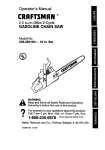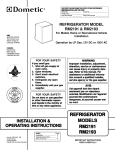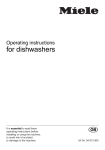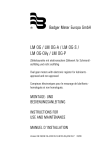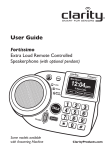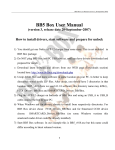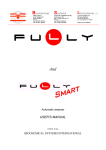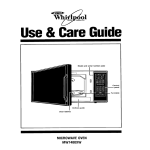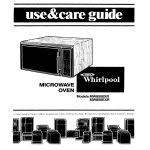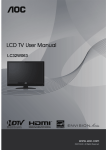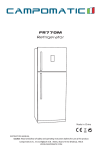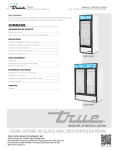Download GE Monogram ZSC2200 Oven User Manual
Transcript
OPERATING AND INSTALLATION INSTRUCTIONS FOR DOMETIC REFRIGERATORS TYPE: A30-80K MODEL RM 123E (Bottled Gas and 12/230 Volt Operation) MODEL RM 122F (Bottled GAS AND 12 Volt Operation) 207.4495.02 0402 IMPORTANT USER INFORMATION It most important that this instruction book should be retained with the appliance for future reference. Should the appliance be sold or transferred to another owner, always ensure that the book is supplied with the appliance in order that the new owner can be acquainted with the functionning of the appliance and the relevant warnings. These warnings are provided in the interest of safety. You must read them carefully before installing or using the appliance. This product is designed to be operated by adults. Children should not be allowed to tamper with the controls or play with the product. Any electrical work required to install this appliance should be carried out by a qualified electrician. This product should be serviced by an authorised Service Engineer and only genuine spare parts should be used. It is dangerous to alter the specifications or modify this product in any way. Care must be taken to ensure that the appliance does not stand on the electrical supply cable. These refrigerators are designed to be used specifically for the storage of edible foodstuffs only. There are workings parts in this product which heat up. Always ensure that there is adequate ventilation as a failure to do this will result in component failure and possible food loss. See installation instruction. Parts which heat up should not be exposed. Wherever possible the back of the product should be close to a wall but leaving the required distance for ventilation as stated in the installation instructions. Before defrosting, cleaning or maintenance work is carried out, be sure to switch off the appliance and unplug it. The ice box in this appliance contains tubes through which the refrigerant passes. If these are punctured this would cause substantial damage and result in food loss. DO NOT USE SHARP INSTRUMENTS to scrape off frost or ice. Under no circumstances should solid ice be forced off the ice box. Solid ice should be allowed to thaw when defrosting the appliance. See defrost instructions. The appliance should be left for 2 hours after installation before it is turned on in order to allow refrigerant to settle, unless it is of the absorption type in which case it can be turned on immediately. This appliance is heavy. Care should be taken when moving it. Ice lollies can cause frost burns if consumed straight from the freezer. Frozen food must not be refrozen once it has thawed out. Manufacturers' food storage recommendations should be strictly adhered to. Refer to relevant instructions. Do not place carbonated or fizzy drinks in the freezer as it creates pressure on the container which may cause it to explode resulting in damage to the appliance. Under no circumstances should you attempt to repair the appliance yourself. Repairs carried out by inexperienced persons may cause injury or more serious malfunctioning. Refer to your local Service Centre and always insist on genuine spare parts. GENERAL GUIDE TO FITTING ANY PLUG Ensure the lengths of wire inside the plug are prepared correctly. Connections should be firmly made after all conductor strands are entered into the terminal posts. When preparing the cable ends take care not to damage the outer sheath, or the insulation surrounding the inner conductors. Tighten all screws. Replace the top cover of the plug and secure. INSTRUCTIONS FOR INSTALLATION 1. INTRODUCTION Before starting to install the refrigerator, please read these instructions carefully in order to obtain a thorough understanding of what is required. When operating, heat is emitted from parts of the cooling unit at the rear and this has to be carried away by air circulating freely over the back of the refrigerator. To ensure sufficient air circulation for satisfactory operation. It is essential that the clearances called for in these instructions are not reduced in any way otherwise cooling performance will be impaired. Providing the refrigerator is installed in accordance with these instructions, it should operate satisfactorily in ambient temperatures up to 32°C (90°F), with some measure of cooling up to about 35°C (95°F). It is recommended that the refrigerator is installed by the caravan manufacturer, the supplier or another qualified person Owners who are competent to carry out the work themselves can do so, but, for the sake of safety, they must take particular care in making the gas connections, checking for leaks, and installing the electrical wiring and fittings. All relevant regulations concerning such installations must be complied with. Many caravans are already provided with a recess, usually in the form of a cupboard which has been specially designed so that it can be adapted, by removal of its door and shelves, to house a refrigerator. Some caravan manufacturers have also devosed kits of parts to aid installation of refrigerators in their particular caravans. A ventilator for fitting above the door as shown in fig. 4 is supplied with the refrigerator. The connection pipe, gas cock, and connectors are not supplied as the sizes of these may vary to suit particular installations. The appropriate parts should, however, be readily available from the refrigerator supplier or an Agent dealing in gas fittings 9see note in item 11). The refrigerator weighs approximately 14,5 kg (321b) and the surface on which it is installed must be capable of carrying this weight, plus that of the food, satisfactorily. All surfaces above and adjacent to the flue outlet, and beside and below the burner housing should be of, or covered with, metal or other non-flammable material. 2 IMPORTANT: On motorised vehicles, the refrigerator must be installed well away from fuel tanks, fuel filling inlets, pipes leading from inlets to fuel tanks, and fuel tank breathers. WARNING: Because of the hazards associated with the use of continuous operating bottled-gas appliances with open-flame burners in difficult-to-ventilate confined spaces, and other considerations, Dometic RT do not recommend the installation of their bottled-gas caravan refrigerators on boats, and refrigerators so installed will not be covered by the Company's guarantee. If, however, a boat installation is planned for the refrigerator, reference should be made to British Standard 5482 Part 3, 1979 and to the Thames Water Authority "Launch Digest" and "Launch Specification". Also, current Guide Lines published by local Water Authorities, or the Ship and Boat Builders' National Federation. It should be noted that special Marine Refrigerators are available from Electrolux for use on boats. 2. VENTILATION The refrigerator will always be built into a recess but to enable the unit to operate efficiently, it is essential that air is allowed to circulate freely over the cooling unit at the back to carry away the heat generated during the cooling process 9see fig. 10. The minimum free spaces called for under, behind and over the cabinet must not, therefore, be reduced in any way. The more space provided, particulary behind and over the cabinet, the better the performance you can expect from the cooling unit. ventilator located at top rear. Flue Outlet Flue Outlet ventilator located at top front (a) (b) Arrows indicate air-flow to ventilate cooling unit at rear Fig. 1 3. IMPORTANCE OF LEVELLING 7. BUILDING-IN The downward circulation of refrigerant within the cooling unit is by gravity and the refrigerator has to be reasonably level, when it is stationary, for the cooling unit to operate properly. If the refrigerator is left operating with a sustained list in excess of about 3º in any direction, pockets of liquid refrigerant can collect at various points within the unit impairing or preventing normal circulation of the refrigerant vapour until level conditions return. It is essential, therefore, that the refrigerator is installed so that the ice-tray shelf inside the refrigerator is level in relation to the caravan, in both directions, so that when the caravan is level, the ice-tray shlef is level. While the refrigerator is built-in, adequate space must be left under, over and behind it to allow a sufficient circulation of air over the cooling unit at the back for satisfactory operation. The recommended method of building-in is shown in fig. 5, with the upper ventilator at the front. However, where space limitations do not permit the upper ventilator to be fitted at the front, the alternative arrangement shown in fig. 6 may be adopted and the height of the recess reduced accordingly. A work-surface can then be fitted over the top front of the refrigerator, but it must not over-hang the door where it could interfere with the operation of the travel catch. Securing in the Recess The refrigerator must be secured in the recess to prevent movement. A suggested method of securing is by means of metal brackets about 20 mm (3/4") wide, (which should be made to suit the particular installation), screwed to the rear of the refrigerator by means of the two existing cooling unit fixing screws (fig. 2) and to the rear wall of the caravan 4. CHANGING DOOR HINGES TO OPPOSITE SIDE The refrigerator is manufactured with the door hinged on the right hand side, however, it can be changed to left hand opening if required. Gently place the refrigerator on its back (taking care not to damage the burner assembly0, pull off the gas control knob, then remove the lower ventilator by taking out the screws from each end. Remove upper hinge blade and travel catch blade from top of cabinet. Fit the upper hinge blade and travel catch blade to their new positions on the top of the cabinet and transfer the lower hinge blade to the opposite side. Refit the ventilator by means of the screws, then push the gas control knob onto its spindle so that the flat on the spindle engages the flat in the recess of the knob. 5. CHANGING OUTER DOOR PANEL If required, the outer door panel can be removed and replaced by one of a different material or colour to match other fitments. I can be of rust proof metal or plastic laminate. To do this lay the refrigerator on its back, and remove the bottom section of the door frame held by 3 screws. The existing panel can then be slid out and a new panel slid in, and the bottom section refitted to retain the new panel. The replacement panel should be from 0,5 mm to 3 mm thick, and 350 mm wide x 485 mm high. 6. DIMENSIONS OF REFRIGERATOR Fig. 2 The exterior dimensions of the refrigerator are given in fig. 3. For dimensions of the recess to house the refrigerator when buildingin, refer to item 7. 3 300 mm (11 13/16") 100 mm (4") 15/ ") 16 380 mm (15") 400 mm (15 13/16") 659 mm (25 510 mm (20 1/16") 73 mm (2 7/8") 439 mm (17 5/16") 39 mm ( 1 1/2") Fig. 3 Alternatively, wooden battens may be screwed to the sides of the recess, from front to back, bearing down on the top of the cabinet to hold it firmly, as shown at A, fig. 4. Whichever method is used, it must be possible to remove the refrigerator easily for subsequent servicing purposes. The brackets or battens must be in a position where they will not restrict the air circulation over the cooling unit; they must not be positioned across the cabinet over the fins of the condenser of the cooling unit at the rear, otherwise air-flow will be impaired and performance affected. Fitting the Upper Ventilator To fit the upper ventilator, screw a block of wood approx. 25 mm (1") square x 66 mm (2 5/8) long. to each side of the recess, 16 mm (5/8") back from the front edge, as shown at B, fig. 4. Secure the ventilator to the blocks with a screw through the hole provided at each end. B A Fig. 4 Additionnal Ventilator To reduce the amount of heat entering the caravan, particularly when used in warner climates, an additionnal ventilator (A, fig. 5), may be fitted in the wall of the vehicle, preferably above the level of the top of the refrigerator. (The exterior flue venting kit must still be used). All surfaces above and adjacent to the flue outlet, and beside and below the burner housing should be of, or protected by, metal or other inflammable material. 8. VENT HOLE UNDER REFRIGERATOR A ventilation hole of not less than 13 cm2 (2in2) effective area (40 mm or 1 5/8" diameter) must be provided in the floor below the refrigerator as shown in fig. 5. The hole should lead directly to the outside air through the floor or wall so that, in the event of a gas leak, it would provide an escape outlet for the heavier-than air gas. It should not be too close to the burner where draught could affect the flame. On mobile installations, the vent hole should be shielded against entry of mud etc., by a deflector as shown in fig. 5a, fitted underneath with its "closed" end facing the front of the vehicle. The deflector should be made from a suitable piece of metal, to suit the particular installation. 4 9. FLUE ARRANGEMENT Flue Baffle The flue baffle (4, fig. 10) must be in position in the central tube of the boiler, suspended on its support wire so that the lower end of the baffle is 75 mm (3") above the bottom of the central tube over the burner. The top end of the baffle support wire is bent into the shape of an "O" and rests horizontally on the tp of the central tube. The baffle is correctly positioned during the manufacture ans should not become displaced during normal use. If the flue baffle is missins or is incorrectly located, the cooling unit will not operate properly on gas. Any strapping tape used to retain the baffle support wire to the top of the boiler casing during transit should be removed before installation. Flue Venting Kit The flue gasses must be vented directly to the outside air. Only the flue venting kit (supplied with the refrigerator in the United Kingdom) is recommended for this purpose. It consists of the following parts: Flue Top Complete-G Flue Outlet Cover Plate-B Exhaust Gas Pipe Complete-F Screw-sELF tAPPING. nO. 6 X 1/4in-H The flue top (G) is in the form of a lazy "T" and incorporates an air-break to minimise the possibility of flame extinction due to draughts. Leading from the flue-top, the extension tube (F) has to pass through the wall of the vehicle to direct the flue gasses to the outside. Care must be taken in determining the positions of the centres of the holes in the inner and outer skins of the caravan wall to accept the extension tube. As the amount of space between the back of the refrigerator and the inside wall og the vehicle as well as the thickness of the wall, may vary for each type of caravan, it is not possible to give actual dimensions therefore each case must be considered carefully before starting to make the opening. Take particular care to ensure that the angle is correct so that when in position, the extension tube will line up accurately with the sloping part of the flue-top. The opening mus be large enough to allow the insertion of a layer of non-combustible material around the extension tube as shown in fig. 7, but the opening in the outer skin must not exceed 70 mm (2 3/4") in diameter, otherwise the flange on the flue outlet may not cover it completely. Leave as much space as possible between the side of the ventilator and the flue outlet. 76 mm (3") UPPER VENTILATOR Wooden blocks for securing upper ventilator. 662 mm (26 1/16") Outer Cover of Flue Venting Kit. DIMENSIONS OF RECESS (with front ventilation) 662 mm (26 1/16") Width of recess - 383 mm (15 1/16") Depth of recess - 400 mm (15 3/4") (minimum). 76 mm (3") Height of recess - 400 mm (15 3/4") min VENT HOLE 40 mm (1 5/8") Dia. to outside air, through floor or wall on opposite side to burner. Vent hole in floor (see fig. 5a). Where recess is above floor height, the vent should be extended through a pipe to the outside. FIG. 5a Fig. 5 76 mm (3") Ventilator Work surface Soft selaing compound Non-combustible material 100 mm (4") minimum Fig. 6 5 Fig. 7 F G 3 2 1 H 4 Fig. 8 When the opening has been made in the caravan wall, the extension tube (F) may need to be shortened to suit the particular installation. To determine if this is necessary, fit the flue top (G) to the top of the central tube of the boiler casing and secure it by means of the screw (H). Place the refrigerator into position, then insert the free end of the extension tube through the wall of the caravan and over the outlet of the flue-top as far as it will go. Measure the length 'X' (fig. 9) of any tube protruding from the outside. Transfer this measurement to the other end of the tube as shown at 'Y' (fig. 9) and cut at right angles through the tube at this point to shorten the tube to the correct length. Note 1. If the caravan wall is not vertical or is contoured in the vicinity of the flue outlet, it may be necessary to make a packing piece from metal or other non-combustible material, of a suitable shape to ensure that, when in position, the plate on the flue outlet is parallel with the back of the refrigerator. Note 2. It is not advisable to lengthen the flue venting arrangement for more than a short distance as this may result in the flue gasses becoming prematurely cooled and water vapour (which is produced during the natural process of combustion) condensing in the flue and running back into the boiler insulation and burner. At this stage, refer to items 10 and 11 in order to prepare for the 12V and bottled gas connections. When these have been made, before finally positioning the flue extension tube (F), ensure that the portion passing through the wall of the vehicle is surrounded by noncombustible material as shown in fig. 7. Use a soft sealing compound between the flange of the flue outlet and the wall of the caravan to prevent ingress of rain water. Fit the outer cover (B) by means of 4 screws. It will be necessary to remove the outer cover and withdraw the extension tube before the refrigerator can be moved out of position at any time. CUT HERE Fig. 9 6 5 1.Flue Baffle. 2.Therminal block 12 V. 3.Heating element 12 V. 4.Therminal block 230 V (under the cover). 5.Heating element 230 V. Fig. 10 10. ELECTRICAL INSTALLATION On model RM123, the boiler of the cooling unit is fitted with two separate heaters, rated at 75W, for use on 230V a.c. mains electricity, and the 12V battery in the car when the caravan is on tow. Model RM122 does not have a 230V heater fitted. The electrical installation must be carried out in a proper and durable manner, taking into account all relevant regulations and codes of practice. For mains voltage operation, it is important that the circuit to and in the caravan is effectively earthed. All mains voltage wiring in the caravan must be installed in accordance with current IEE Regulations including the use of an outlet and coupler to BS 4343/CEE 17. a) Wiring for Electronic Igniter (where fitted) The electronic igniter for the gas burner is for permanent connection to a 12V d.c. supply, e.g car battery. In a motor-van, the igniter can be connected directly to the vehicle's main battery or to an existing 12V circuit in the vehicle which will remain on continuously and will not be switched off when the engine is switched off. In a caravan, in order to maintain the supply when the towing vehicle is unhitched, the igniter must be connected to an auxiliary battery in the caravan. The current drain of the igniter is negligible therefore the battery can be one that is also used for operating other equipment in the caravan such as the water pump, lights, etc. Connect the igniter terminal block (fig. 11) to the battery, ensuring that correct polarity is observed-the terminals marked' + and'-' must be connected to the similarly marked terminals of the battery. The wire used for connecting should be at least 0,5 mm2 in cross-sectional area and a 0.5 or 1.0 amp inline fuse should be fitted in the feed wire, as near to the battery as possible. Burner housing Bottom of refrigerator Igniter terminal block Housing for electronic components Iigniter switch View of bottom of refrigerator showing electronic igniter layout Fig. 11 b) Mains Voltage Connection For connection to a 230V electricity-supply, the refrigerator has a 3core mains lead which is intended for connection to a oroperly earthed plug and socket outlet. The socket outlet should be fitted in the caravan in a position readily accessible to the user, within reach of the mains lead. In the United Kingdom, the plug and socket outlet should be of the non-reversible type. IMPORTANT: The wires in the mains lead of this appliance are coloured in accordance with the following code: GREEN AND YELLOW = EARTH. BLUE = NEUTRAL. BROWN = LIVE. As the colours of the wires may not correspond with the coloured markings identifying the terminals in your plug, in the United Kingdom, proceed as follows: Green and Yellow, 3 AMP FUSE, E, N, Lrown, Coro Clamp. The wire which is coloured GREEN AND YELLOW must be connected to the terminal in the plug which is marked with the letter E or by the earth symbol or coloured green or green and yellow. The wire which is coloured BLUE must be connected to the terminal which is marked with the letter N or coloured black. The wire which is coloured BROWN must be connected to the terminal which is marked with the letter L or coloured red. WARNING-THIS APPLIANCE MUST BE EARTHED In the United Kingdom, the plug or circuit to the refrigerator must be fitted with a fuse not greater than 5 amps. If a 13 amp (BS 1363) fused plug is used, it should be fitted with a 3 amp fuse. In other countries the fuse rating will depend upon the voltage and local practice. c) Wiring for 12V Operation (See figs. 10, 12a and 12b). For operation on 12V, the boiler of the cooling unit is fitted with an 75 watt heating element (2, fig. 10) connected to a terminal block (3) attached to the back of the refrigerator. Before installing the refrigerator, the wiring for the 12V supply should be connected to the terminal block, leaving enough slack subsequent insertion and withdrawal of the refrigerator for servicing purposes. The wire used for connecting must be at least 2 mm2 in crosssectional area (e.g. 28/030 mm) and should be kept as short as possible. Polarity is not important therefore is does not matter which way round the two wires are connected to the terminal block on the refrigerator. 7 A suitable size switch or plug and socket should be fitted in a convenient position in the wiring in the caravan so that the refrigerator can be readily disconnected from the 12V supply when 12V operation is not required, see fig. 12a. To prevent undue voltage drop (which would impair the performance of the cooling unit) the wiring for the 12V refrigerator supply should be connected directly to the terminals of the main battery in the towing vehicle and not to an auxiliary battery in the car or caravan. Existing wiring in the car should not be used for the refrigerator supply as this would normally be intended for a different purpose and may not be capable of carrying the 7 amp (min.) load of the refrigerator satisfactorily. The chassis or body of the caravan should not be used as a substitute for one of the wires otherwise voltage drop is almost certain to occu either now or later on. The body of the car can, however, be used in place of one of the wires for the 'earth' return but the connection to it must be well made, with paint, grease, etc., removed from the area of contact and it should be located in a position protected from the weather, such as inside the boot. A 15 amp, continuous rating, fuse must be incorporated in the supply to the refrigerator, as near to the battery as possible. A good quality fuse holder should be used having adequate size well-made contacts which will carry the current load without undue resistance. When operating on 12 volts, the refrigerator has a relatively high current consumption (7 amps) and it is only intended to be used by this method of operation whilst the engine is running and charging the battery otherwise the battery may become discharged to a point where it will not re-start the car engine, 12 volts operation is not thermostatically controlled and the 75 watts heater is 'on' all the time the refrigerator is connected ti the 12V supply and any switches in the line are 'on'. Note: to minimise the possibility of a drained battery due to the refrigerator being inadvertently left operating when the engine is at rest, it is strongly recommended that a suitable relay device is fitted in the car, in circuit with the ignition switch, so that when the engine is switched off, the refrigerator is automatically switched off-see Fig. 12b. 11. GAS CONNECTION The gas installation should only be carried out by a person experienced in gas fitting. It is recommended that the gas pipe feeding the refrigerator is run underneath the caravan and is so arranged that it is possible to turn off the supply to all appliances other than the refrigerator when they are not required. The supply pipe should preferably be of copper; if any other material is used, it must of a type approved for use with continuously operating bottled gas appliances and have threaded connections throughout. Push-on connections must not be used. (We do not recommend the use of "rubber" type flexible tubing for connecting permanently operating appliances of this type in the United Kingdom). All connectors, etc., should be of a type specifically designed for the connection pipe used. Screwed joints should be sealed with a jointing compound approved for use with bottled gas. The gas supply pipe should be connected to the 1/8" B.S.P. female inlet adaptor (located underneath the refrigerator) by means of a suitable threaded coupling - see note below. The inlet adaptor will accept a 1/8" B.S.P. male thread. (Access to the inlet adaptor may be obtained by pulling off the knob of the gas control valve then removing the lower ventilator by taking out the screws at the ends). Depending ont the location of the gas supply pipe, it may be necessary to connect a piece of cooper pipe to the inlet adaptor on the refrigerator before placing the refrigerator in the recess. This pipe should be of suitable length and pre-shaped so that, when the refrigerator is in place, the end of the pipe will be in a convenient and accessible position for connection to the main gas supply or to another piece of pipe coming from the main gas pipe. In making the connection to the refrigerator, it is recommended that a union gas cock of an approved type for bottled gas is incorporated in the supply line a position which is readily accessible to the user. For eventual servicing purposes, the union should be on the outlet side of the cock and the pipework should be positioned so as not to prevent the refrigerator from being readily withdrawn. After the refrigerator has been connected, all accessible connectons should be checked for soundness by applying a soap/water solution over them and watching for bubbles with, of course, the bas-bottle and any gas cocks in the line, turned on. DO NOT USE A FLAME. Thereafter, all connections should be checked periodically, in the same way, to ensure that they have not loosened in use. Caravan Car Optional Relay (see also fig. 12b) Two cores (red for the supply, white for the common return) of 7-core 'ISO 4141' flexible cable 2 mm2 (minimum) wire Two 2 mm2 (minimum) wires 15 amp. fuse Main 12V battery in car Type 12S (Supplementary) 7 pin Terminal block on back of plug and socket Switch or plug refrigerator. (Leave sufficient slack wire for refrigerator to and socket be withdrawn). FIG. 12a 12V WIRING ARRANGEMENT Fig. 12a Battery Fuse Supply to Refrigerator RELAY Ignition Controlled Feed DIAGRAM SHOWING AN IGNITION CONTROLLED RELAY IN THE WIRING TO THE REFRIGERATOR Fig. 12b INSTRUCTIONS FOR USE Travel catch Ice-tray Drip collector Flame control tube Gas controls Fig. 13 14. INTRODUCTION To ensure satisfactory operation, it is essential that the refrigerator is installed and used as directed in this instruction booklet. The ventilation openings above and below the refrigerator must not be reduced in size or obstructed in any way otherwise the performance of the cooling unit may be impaired. 8 Levelling When the refrigerator is operating, liquid refrigerant trickles theough the pipework of the cooling unit under the influence of gravity. To enable a satisfactory flow to take place, the unit must be reasonably level, from side to side and from front to back, otherwise refrigerant can accumulate in pockets instead of flowing back to the bottom, and the cooling process may be impaired or cease. In a caravan on tow, the usual continuous rolling and pitching motion, even on long hill climbs, will not normally cause the operation of the cooling unit to be affected unduly, but when the caravan is at rest for more than about half an hour, a list of more than about 3º in any direction may interfere with the operation. (Note: 3º corresponds to about 50 mm at the end of a metre-long plum-line, or 1 1/2" at the end of a 30" plumb-line). If the list does not exceed 8º, cooling is usually resumed when the refrigerator returns to the upright position, but if it does exceed 8º, the burner should be extinguished or the electricity supply disconnected, as applicable, soon after the list has occurred otherwise the cooling unit may become damaged due to overheating of the boiler. When the caravan is to be at rest for a period, with the refrigerator operating, the caravan should be levelled, in both directions, so that the refrigerator is level. This can be checked with a small spirit level placed on the ice-tray shelf inside the refrigerator, viewed from above with the aid of a small mirror. If it is not convenient to level the vehicle and it is to stand out of level for more than half an hour, the refrigerator should be temporarily turned off. Note:-Having checked initially that the refrigerator has been installed level in both directions in relation to the caravan, you may find a more accessible flat surface on which to place the spirit level during future levelling operations. A position on the caravan draw-bar, for instance, for placing (or permanently fixing) a 2-way or circular spirit level, where it may be viewed whilst adjusting the jockey wheel height, will be an aid to speedy levelling of the caravan and, therefore, the refrigerator. Lighting the Burner 1. Ensure that gas is available from the bottle and turn on any taps in the supply line to the refrigerator. 2. Open the refrigerator door to give easier access to the gas controls. 3. Turn the gas control knob (4) to the maximum position (No. 3) then press in this knob for about 5 to 10 seconds to clear air from the pipeline. (When starting initially, or after changing a gas bottle, it may be necessary to press in the knob for a longer period to clear all the air from the pipes). 4. Still pressing in the knob (4), push in the button (5), which operates the Piezo igniter, several times in quick succession until the burner lights. Continue to press in the gas control knob (4) for a further 15 seconds to allow time for the thermocouple tip (over the burner) to heat up. 5. Release the gas control knob then check that the burner is alight by looking in the flame control tube. If the burner has not lit, repeat the lighting procedure. Note:-The refrigerator has a flame failure device which will automatically shut off the gas to the burner if the flame is blown out. While the knob (4) is being pressed in, this device is temporarily inoperative. 5 15. GAS PRESSURE Before using the refrigerator on bottled gas check that the types of gas pressure regulator that you intend to use are compatible with the size of burner jet and gas control valve fitted to the refrigerator. 16. STARTING THE REFRIGERATOR (see fig. 14) Before using your refrigerator for the first time, it is advisable to wash the interior and its accessoiries as described later under 'Cleaning'. The bottled gas equipment includes a Piezo crystal lighting device which creates a spark over the burner when the button (5) is pushed in fully. No batteries or flints are required to operate this lighter. Before starting the refrigerator, always check that the alternative method of operation is 'off' as the refrigerator should not be operated by both means at the same time. If the caravan is to be stationary for a period, check that the refrigerator is level. When turning the gas control knob (4) from one position to another, the knob must first be pushed in. 2 3 5 4 Fig. 14 9 4 Fig. 14a Lighting the Burner (Models with Electronic Igniter) For models fitted with the electronic ignition system follow Item 16 up to point 2 then proceed as follows:3. Switch on the electronic igniter switch (5) by pushing in the right-hand end against the symbol 'I'. The light in the switch should start flashing, indicating that sparking is taking place. 4. Turn the gas control knob (4) to the maximum position (No. 3) then press in this knob and keep it held in. 5. When the burner lights, the neon light in the switch will stop flashing and go out. When this happens, keep the knob (4) held in for a further 15 seconds dir the thermocouple over the burner to heat up, then release the button. If the light in the switch starts flashing again, it indicates that the flame has gone out. In this case, repeat operation No. 5. 6. When the burner has lit, leave the igniter switch in the 'On' position. If the flame goes out, due to a gust of wind for instance, the igniter will then immediately start sparking and re-light the burner. Note: If the burner does not re-light within about a minute,the flame failure device will operate and shut off the flow of gas to the burner. The neaon light in the switch will still continue to flash, however, to alert you that something is wrong or that tha gas bottle is empty. Emergency Lighting Procedure for Gas Burner Although the electronic igniter is primarily designed for connection to a 12V car battery, it will operate from a 9V dry cell. If the recommended car battery connection is not available, the burner can be lit by using a type PP3, PP7, PP9, or equivalent battery, as used for radios, etc. If using this method, '+' and '-' polarity must be observed otherwise the igniter will not operate. 17. Electric Operation (230V a.c.) Model RM123 only. IMPORTANT: Before connecting any mains voltage electricity supply to a caravan, always make certain that the supply has an effective earth connection and that polarity is correct in relation to the mains voltage wiring in the caravan. For safety, it is essential, particularly for overseas use, to check for earth continuity and correct polarity of the connected supply. (There are different makes of proprietary polarity and Earth Continuity monitors on the market for this purpose). To start the refrigerator on mains voltage electricity, see that the gas control knob (4, fig. 14a), the igniter switch (5, fig. 14a), and the 12V supply are off. Connect the refrigerator to the electricity supply socket and switch on. Turn the electric thermostat dial (6, fig. 15) so that setting 3 or 4 is against the indicator mark. FIG. 15 (6) 6 It is preferable to start the refrigerator with the control knob set at the Maximum flame position (No 3). After an hour or so, it may be turned to the Medium (No 2) or Minimum (No 1) positions, to provide the cooling required under the prevailing conditions. In warm weather, or with a heavy food load, or frequent door openings, the Medium or Maximum position will usually be needed, but, in cold weather it may only be necessary to use the Minimum flame position. Remember to alter the setting, as necessary, if there is an appreciable change in room temperature or conditions of use. When operating on mains electricity, the refrigerator temperature is thermostatically controlled ant the thermostat dial (6, fig. 15) should be set with No. 3 or 4 against the indicator mark. Suitable temperatures will then be maintained in the fridge for general use but, in hot weather, or if more cooling is required, turn the dial to a higher number. For less cooling, turn it to a lower number. 19. STORING FOOD IN THE REFRIGERATOR Four half-depth shelves are provided. Two can be used together to form a full size shelf (with the rear one reversed so that its raised edge is at the back), or they can be used separately in the four locations in the lining to leave space for bottles at the front. To prevent drying out and the transfer of flavours from one food to another, always store foods in covered containers or plastic bags. When 'on the move', crumpled pieces of clean paper may be wedged (temporarily) between the various items to retain them. Never put hot food into the refrigerator. Remember to engage the travel catch when the caravan is to be on tow (see next item). 20. ICE-MAKING Fig. 15 17a. 12 VOLT ELECTRIC OPERATION When the caravan is on tow, it is recommended that the refrigerator is operated electrically, i.e. from the 12V battery in the towing vehicle, and not by means of bottled gas. It is important to understand that 12V operation is intended only to be used whilst the car engine is running and charging the battery, and for short periods when at rest, otherwise the battery may be discharged to a point where it will not re-start the engine. When the caravan is at rest for more than a relatively short period, say about half an hour, the caravan should be levelled, the refrigerator disconnected from the 12V supply, and, if required, started up on bottled gas or mains electricity. For operation on 12V, the boiler of the cooling unit is fitted with an 75 watts heating element (2, fig. 10), connected to a two way terminal block (3) at the back of the refrigerator, 12V operation is not thermostatically controlled therefore the cooling unit will operate all the time the refrigerator is connect to the 12V supply. (As 12V operation is intended for use only while the caravan is on tow, overcooling is unlikely because of the comparatively short time involved. If overcooling does occur during extended towing periods, the refrigerator may be disconnected periodically as experience proves necessary). The wiring in the car and caravan to supply the refrigerator from the main battery in the car should have been installed in accordance with item 10 on page 6 of the installation section. To use the refrigerator, on 12V, check that the gas is turned off, then connect together the plug(s) and socket(s) fitted during installation, and switch on any switches in the circuit to the refrigerator. Note:-Before operating the refrigerator on 12V, it should be precooled, together with its contents, by running it on bottled gas for a few before changing over to 12V and starting on a journey. 18. TEMPERATURE REGULATION After starting the refrigerator, it will take about an hour before the icetray shelf shows signs of cooling. The gas control knob (4, fig. 14) has four positions, marked 'Off', and 3, 2 and 1, representing three sizes of flame- Maximum, Medium and Minimum. The amount of cooling produced in the refrigerator will depend on the size of flame used. 10 Fill the ice-tray with water to within 3/16 inch (5 mm) from the top, and place it on its shelf inside the refrigerator. When the ice has formed, the tray can be released fron the shelf simply by lifting one corner. When operating on gas, ice will be made more quickly if the control knob (4, fig. 14) is temporarily turned to the Maximum flame position (No. 3). 21. TRAVEL CATCH The travel catch (fig. 16) is to keep the refrigerator door securely closed when the vehicle is on the move. Remember to push the catch down so that its lower end fully engages the plastic bush in the top of the door, before moving off. Fig. 16 22. DEFROSTING Frost will gradually form on and under the ice-tray shelf. It is a mistake to assume that an accumulation of frost gives a colder cabinet. For the most efficient operation, the refrigerator should be defrosted regularly-usually about once a week or ten days, depending on the particular conditions od use. To defrost, turn off the gas, empty the cabinet, remove the ice-tray and leave the cabinet door open. The frost will melt and run into the drip collector (fig. 13). When defrosting is complete, remove the drip collector by carefully sliding it forward, and empty it of water. Wipe dry the ice-tray shelf, replace the drip collector, turn on the gas and relight the burner. Rinse out the ice-tray, refill it with fresh water and replace it. Note:-Do not attempt to defrost more quickly by means of an electric fire or other form of heat as this may damage the plastic surfaces. 23. CLEANING If the refrigerator is not cold enough it may be because: 1. The ventilation is inadequate owing to objects such as wire mesh or winter covers blocking the ventilation passages. 2. The evaporator is frosted up. 3. The temperature control setting is incorrect. 4. The gas pressure is incorrect - check the pressure regulator at the gas container. 5. The ambient temperature is too high. 6. Too much food is loaded at the same time. 7. The door is not properly closed. 8. More than one source of energy is used at the same time. If the refrigerator still does not work properly, call a service engineer. The sealed cooling system must not be opened, since it contains corroding chemicals under high pressure. Clean the refrigerator thoroughly at intervals as necessary. Turn off the gas, empty the cabinet and defrost as described above. The refrigerator and its accessories may then be cleaned with a soft cloth wrung out in a weak solution of bicarbonate of soda and warm water. Finally, wipe over with a cloth rinsed in warm water only and dry thoroughly. Do not wash any plastic parts in water that is more than hand hot and do not expose them to dry heat. NEVER USE STRONG CHEMICALS, ABRASIVES, OR HIGHLY PERFUMED CLEANING MATERIALS ON ANY PART OF THE REFRIGERATOR. Replace the accessories and re-light the burner. MAINTENANCE 24. WHEN NOT IN USE MAKE SURE THAT Whenever your refrigerator is to be out of use for a period, turn off the gas or disconnect from the 12V supply, as applicable. Empty the cabinet and defrost as described earlier. Clean and thoroughly dry the interior and accessories and leave the door open otherwise the air inside may go stale giving rise to an unpleasant odour which could be difficult to remove at a later date. 25. CONSUMPTION The approximate gas consumptions at the various settings of the gas control knob are given below. GAS CONTROL SETTING Bottled Gas Ib liquid/24 hours kg per 24 hours 1 0.31 0.13 2 0.39 0.17 3 0.47 0.2 IF THE REFRIGERATOR FAILS TO WORK Check the following points before calling a service technician: 1. That the "STARTING THE REFRIGERATOR" instructions habe been followed. 2. The refrigerator is level and not tilted in any direction. 3. If it is possible to start the refrigerator on any of the connected sources of energy. 4. If the refrigerator fails to work on gas, check. That the gas bottle is not empty. That all LP-gas valves are open. 5. If the refrigerator fails to work on 12V, check. That the 12V supply is connected to the refrigerator. That the fuse on the 12V supply is intact. That the 12V switch is on. 6. If the refrigerator fails to work on 230V, check. That the 230V supply is connected to the refrigerator. That the fuse is intact. That the thermostat is not switched to the 'off' position. Inspect the gas hose periodically for cracks or deep chafing marks. Couplings can be tested for leaks using a soap solution. Do not use an open flame!If there is any suspicion of damage, call for a service technician. We recommend that a service technician check the refrigerator once a year. SOME USEFUL HINTS The refrigerator is not operating on 12V when the vehicle is parked, otherwise you will drain the car battery in a short time. Defrosting is carried out periodically. The refrigerator is clean and dry with the door left open when it is not to be used for some time. Liquids or items with a strong odour are well packaged. The ventilation openings are unobstructed. The door is secured by means of the travel catch when the caravan is on the move. Only one mode of operation at a time is used to run the refrigerator. SERVICE AND SPARE PARTS Service and spare parts are obtainable from your dealer - consult the yellow pages of the tlephone directory. RECYCLING After unpacking the appliance, the packing materials should be delivered to a local collection site. At the end of its useful lifetime, the appliance should be delivered to a specialized collection and reprocessing firm, which reclaims the usable materials. The rest is properly destroyed. 11 This Guarantee is offered, to you as an extra benefit and does not affect your legal rights. GUARANTEE (United Kingdom only. For other countries, please refer to your supplier). These products are carefully designed, manufactured, tested and inspected and in consequence we undertake to replace or repair any part found to be defective in material or workmanship, within ONE YEAR from the date of delivery to the original purchaser, free of any charge. This guarantee does not apply unless the refrigerator is installed in accordance with DOMETIC Installation Instructions, and the Company does not accept liability for defects arising from neglect, misure, or accident. Proof of the date of purchase will be required before service is provided under the terms of the guarantee. Addresses where service can be requested are listed separately. For your future reference, please complete the following details on delivery of your refrigerator. Date of purchase............................................. Purchased from This appliance complies with the following EEC directives: LVD-Directive 73/23/EEC with amendment 90/683/EEC EMC-Directive 89/336/EEC Gas-Directive 90/396/EEC. ELV-Directive 2000/53/EC The appliance does not contain any CFCs/HCFCs. Sodium chromate is used for corrosion protection (less than 2 weight % of the coolant). DOMETIC LTD. 99 OAKLEY ROAD LUTON, BEDFORDSHIRE LU4 9GE Printed by Xerox Hungary Ltd. DOMETIC RT. may introduce modifications to thier products from time to time consequently the details given in this leaflet are subject to alteration without notice. Rev.: 2003. 11. 28. A LUX MODEL












